In the fall of 2014, students and their teacher at Parsons New School for Design undertook a semester-long exploration of technology, design, and its histories in a course titled "Design and Technology: A History." The culmination of their questioning and exchanges is provided here, along with another beginning.
Don't wanna be here? Send us removal request.
Text
Constructed Worlds in Photography: An Exploration of Truth
by Gunner Streitzel
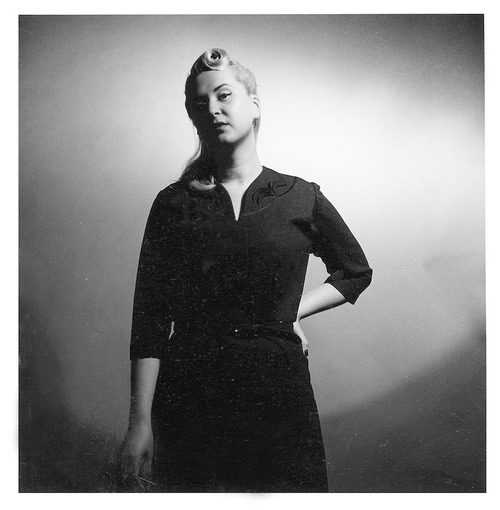
Truth is a constant. It's a fact in the way that it remains unchanged regardless of one's beliefs or perceptions about any given thing. Between the decisions made when a photograph is being taken, the decisions being made on what photographs to present the world, and the interpretations projected onto the photographs from the viewers, there are just too many factors in play that would allow a photograph to be a constant, to be a truth.
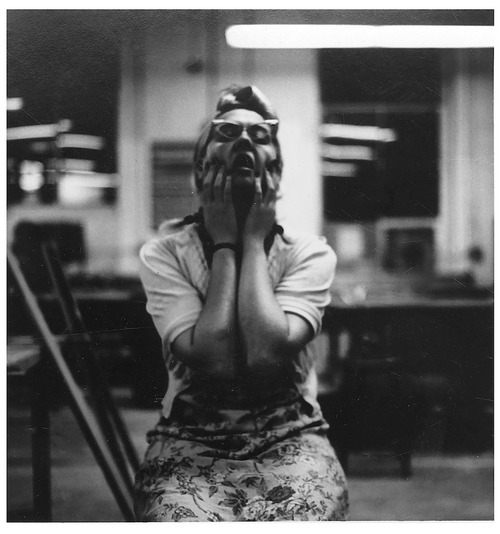
My final project explores composition, posing, and the selection process to demonstrate assumptions made about photography and the need for context when viewing photographs. Subjects were photographed in two settings: 1. the studio and 2. the environment they thought most reflected them. These images begin to show the active roles of the photographer and curator in what the photographs reveal.
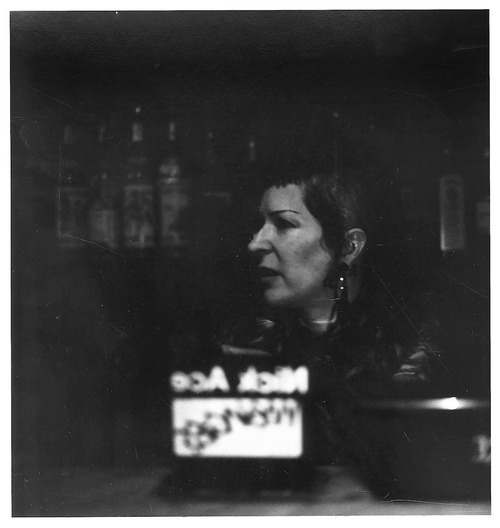
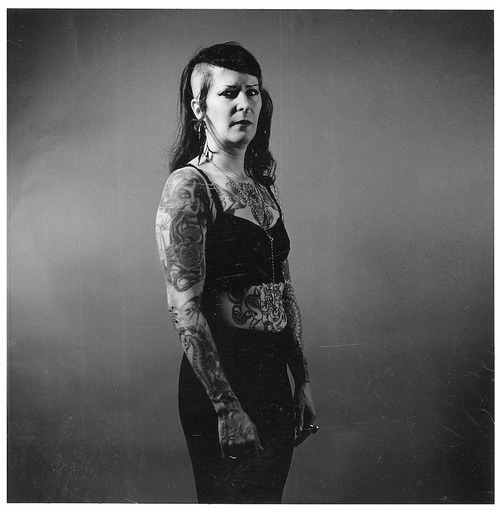
2 notes
·
View notes
Text
Nonverbal Elements of Language: The Hidden Layers of Speech
by Sofia Oom
Unarguably, the most common, natural, and oldest communication technology, language is both an intrinsically simple and extraordinarily complex tool humans have developed. All of us are born within a community that uses verbal codes to exchange inner ideas. However, this technology that seems so natural to us relies on not only words, but also other elements. Given the amount of hidden layers in speech, the challenge of mastering a second language becomes a very difficult one to overcome.
My project explores the verbal, information aspects of language as well as its nonverbal, emotion aspects. Considering words the medium and gestures the social content of a message, I asked individuals to relay an anecdote in their native language and then again in English, which for all was not their first language. In every case, the body language of the individuals became more reserved when telling their story in English. Given the importance of interpreting tone, expression, and gesture in communication, my video shows the greater difficulties of communicating in a second language when these nonverbal elements may be downplayed. Ultimately, I found that the complex hidden layers of speech, the ones that we think our brain doesn't bother spending time interpreting but unconsciously does, are more difficult to master than speaking words and grammatical rules when speaking a foreign language.
2 notes
·
View notes
Text
Trust through Technology: Communication Channels Today
by Henrik Emil Roemhild
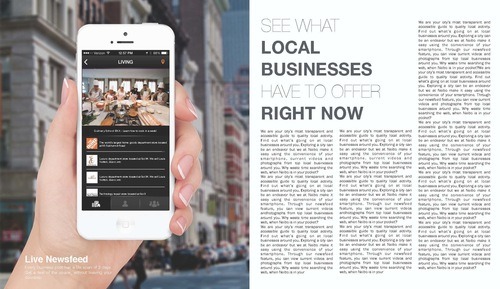
Technology has changed the way we interact with each other. In terms of communication, we now have the luxury of interaction at will in various forms and levels. Due to the evolutionary process granted by technological development, there has been a paradigm shift in the way we communicate and perceive. In particular, new marketing channels have transposed the way information is depicted, how we connect with people, and how we reach people. My project presents a two-fold approach to address the ways businesses communicate through media: 1. a smartphone app that provides direct communication between local businesses and the public and 2. a marketing campaign that highlights the way this app may generate trust between businesses and the public through, not in spite of, technology. My project is meant as an intervention to counteract the skepticism of social media users that arises is response to the abundance of perspectives and opinions, yielding information that can never be fully relied on.
1 note
·
View note
Text
Urban Planning Non-Neutrality: Designer as Medium
by Eva Cruz
To state that something just happens because it happens, or that something is just because it is, is a common statement that arises daily when one disregards the question concerning what things are and why they happen. It is easily forgotten in the daily scheme of things that everything we interact with is designed with a purpose. One of the places where we spend most of our time is where we live, our neighborhoods. But as a neighborhood begins to change, those who live there are, most of the time, only spectators of the shift happening around their own homes.
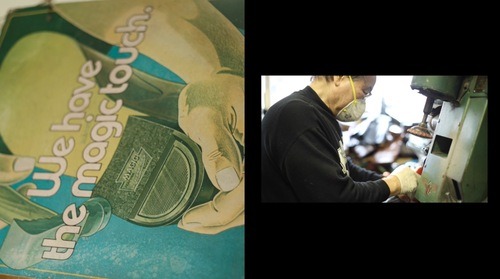
In my project, I address the network of neighborhoods in a city and what is needed if one is to work properly. The diversity of a neighborhood should be viewed as a positive system, for it promotes small businesses and residential homes for people to thrive in. I look to disclose the importance of the responsibility of the designer, further addressing that what is made serves a function, is non-neutral, and directly affects society as a whole. Considering the designer as problem-solver and communicator, I provide a moving picture (full video is available here) of a neighborhood in transition, my own neighborhood of Greenpoint in Brooklyn, New York. Hearing the words of Jane Jacobs while images of Greenpoint convey the spectrum of life, viewers are asked to consider the importance of urban designers and their responsibility to create systems that are based on the need of human-centered design.
2 notes
·
View notes
Text
Lettuce on the Internet: Valuing Net Art
by Harry Koepp
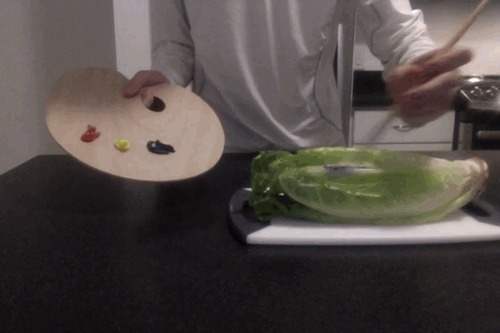
The widespread access to the Internet that has been made available to the masses over the past decade(s) has been transformative to almost every segment of the economy. Concurrently, it has allowed the next generation of artists and designers to express their ideas and aesthetics in new and previously unimaginable ways. Much in the same way that modernists responded to the industrial economy, the innovations of their time, and the cultural shifts that sometimes resulted, Net Artists seek to delve into and comment on the effects of the twenty-first-century digital economy and, specifically, the way that technology has altered social dynamics and human interactions on a fundamental level.
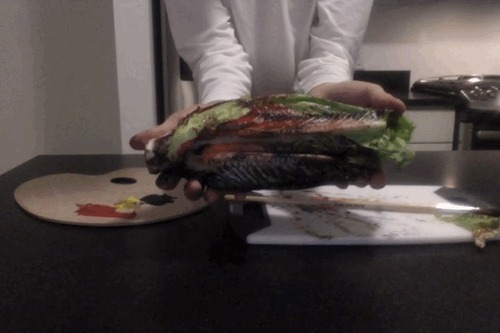
My project attempts to articulate the layers of intangibility that digital art introduces. I created a work of digital art Lettuce (digital, acrylic on lettuce; GIF may be viewed here) that I then presented for bidding in a self-organized auction. Rather than request monetary bids, I asked: What would you exchange for this digital art object? Bids offered included 10 Facebook "likes," one share of social media, the chalk below the bid sheet, a staring contest, a collaboration, a new cutting board, and one Vine video share. While I decided the share of social media was the "highest" bid, the question remains: Why would someone buy something that could be easily reproduced and does not exist in the physical world?
1 note
·
View note
Text
Virtual Afterlife: Death and Grieving on the Internet
by Lauren Taubenfeld
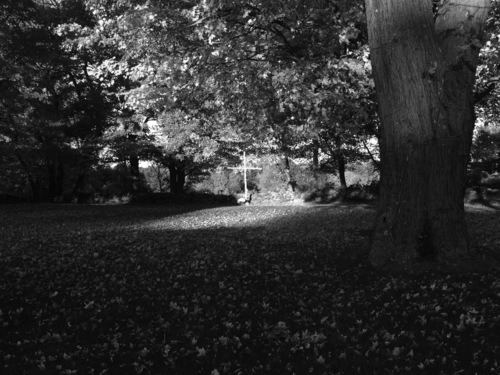
Considering three ways in which we treat death, my project explores traditional, modern, and postmodern frameworks. The modern way we experience death is in private spaces and/or hospitals. The postmodern way conflates the public and private. In the world of new social media, namely Facebook, it can feel strange how quickly the grieving process begins because of technology and the Internet when someone dies. Traditional eulogies have been replaced by online comments and messages to the dead. The lifelike images and videos retained online of the deceased can be compared to momenti mori, the traditional formal Victorian funeral portraiture the advent of photography made possible.
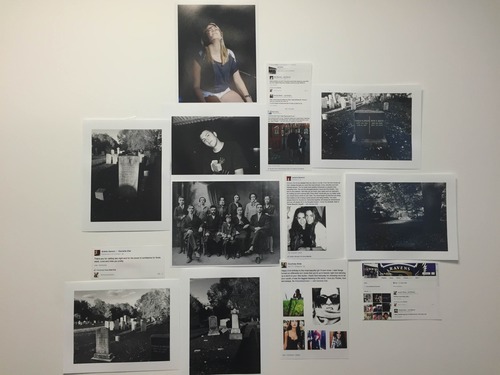
Some may find comfort in holding onto these images and the last ideas of those who have left us, but for me, they cause more confusion than clarity and more pain than pleasure, for the very reason that they are so all-but-real. As the use of social networking sites, Web memorials, and Web cemeteries continue to emerge online, we wonder if writing to and about the dead online has the same effect these therapies have offline. Through a series of photographic images, I explore these issues and effects of choosing Facebook as a venue for memorialization.
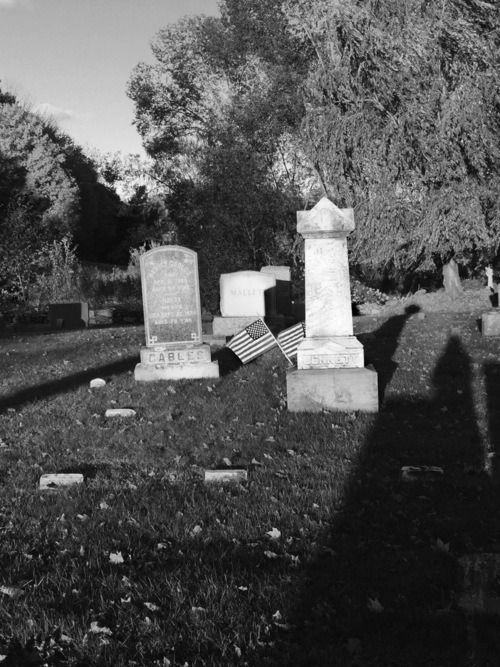
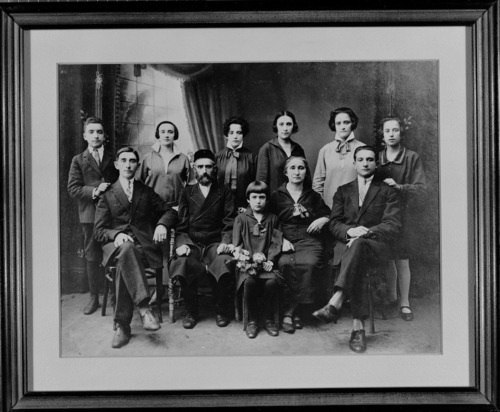
5 notes
·
View notes
Text
Approaching an Object: Concrete versus Theoretical Aspects
by Sharon Kim
In this experiment (full video is available here), I wanted to test Heidegger's claim that states one's initial mode of thinking is within the practical realm. On the table, a stack of papers was accompanied by a ruler, a pen, and a pair of scissors. The participants were instructed to use the objects in whatever way they saw fit. The things that these four people had in common was that they subconsciously approached the scissors in a practical manner as opposed to a theoretical one. The next portion of the experiment was for the participants to critically draw the scissors as realistically as they could. Generally and typically seen in the video, it can be assumed that new appreciations are formed with new realizations of different attributes and details that are revealed through the act of representation.
1 note
·
View note
Text
Surveillance and the Virtual World: Spectator as Gamer
by Marvel Jean-Pierre
Technology has been the tool that has brought the human race and animals alike towards a world of awareness and consciousness. My final project considers two specific types of technologies: the surveillance camera monitor and the gamers monitor. It has come to mind that that the living space that we are existing in is one that is often viewed through a screen. On a day-to-day basis these particular people are sitting in front of a screen watching what is happening on it but they are never really involved in what is happening. When a surveillance security employee is watching everyone in their ongoing lives on a screen, do we become virtualized on that screen like a gamer looking at a virtual world in a game? For my final project, I explored the spectator position within surveillance. In the process of trying to find an answer for my questions I got a glimpse into what someone who would be doing this as a job would feel like.
3 notes
·
View notes
Text
Contemporary Beliefs: Impact of Technology on Religion
by Alejandro Lopez
Throughout the course of the semester we discussed ways that technology and its evolution have affected society as a whole. As we, humans, have evolved through time, we have discovered new truths about our existence, about human nature, and the way we interact with each other as a society. Has the evolution of humans, technology, and science given us enough answers to avoid spirituality or question it? Have these advances stretched to the point where we have lost some sort of meaning in life? What is the purpose of knowing all of these things--do we have a purpose in this world? These are the questions and themes I explored in my final project, presented in a video showing several students expressing their thoughts on these issues.
1 note
·
View note
Text
Language as Technology: Expressing an Inner Dialogue
by Thomas Krantz
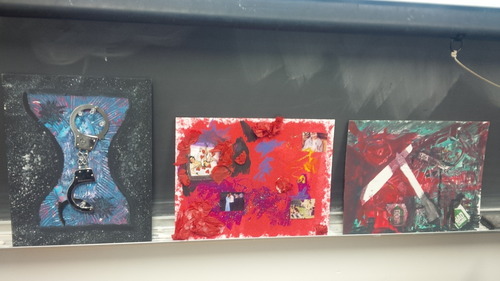
Exploring the possibility of the body being the medium for the mind, this project provides four pieces: three mixed-media painting collages (pictured above) and one paintbrush used in the making of the other pieces. This project raises the question of what determinations we make to pair an object/experience with an emotion. Having viewed the pieces, participants were given a sheet with the following terms: Love/Anger/Frustration/Excitement/Happiness/Fear. Of the above emotions, which one do you feel represents the piece and why? What aspects of the piece allude to this emotion?
1 note
·
View note
Text
Exploring Technology and Education: A Design Approach
by Carlos Hernandez
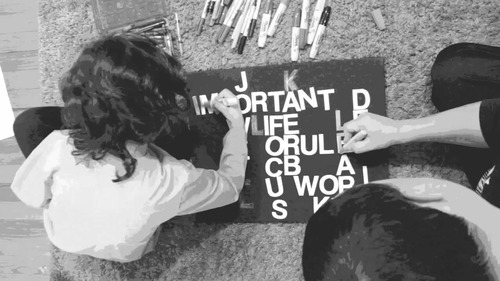
This project (the full video is available here) has allowed me to explore and challenge my own ideas and notions in regard to not only the integration of technology in my everyday life, but personal life as well in the use of such technology to aid in the teaching of creative arts to Jowell, my six year old son, who is the inspiration of my project. Are these mediums helping or hurting the creative juices or perhaps both? The idea behind this exploration is to achieve a better understanding of these consequences and apply the techniques, which are shown to cultivate or aid in creativity.
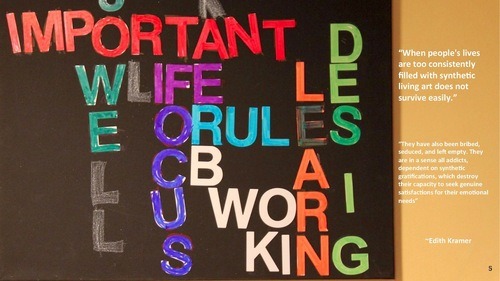
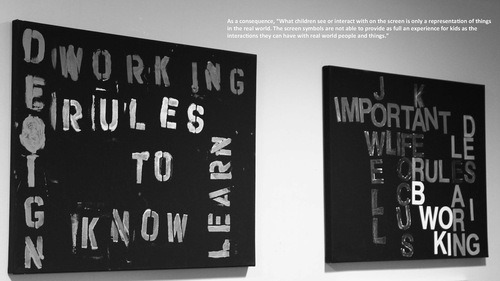
2 notes
·
View notes
Text
Coloring Gender: Shaping Society with Pink and Blue
by Rachel Minjock
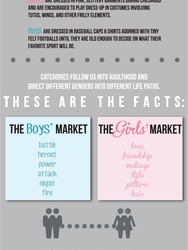
3 notes
·
View notes
Text
Digital Photography as Technology Art
by Heeseok Jung
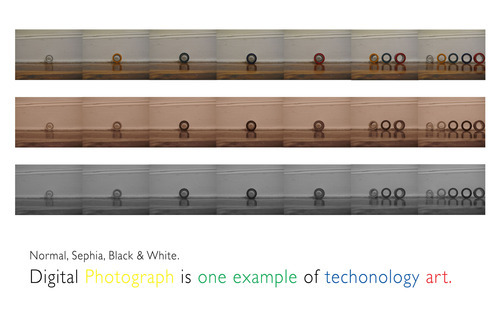
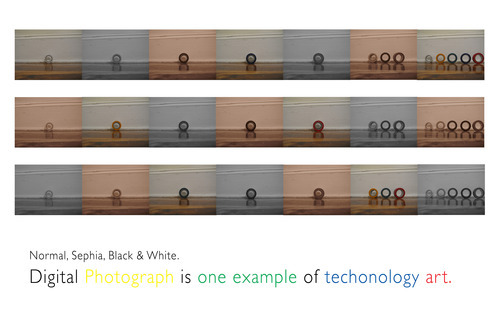
1 note
·
View note
Text
The History of Our Story
by Veronica
We began with a simple question: What is technology? As humans, we not only exist with, but also subsist via technology. So, how has and does technology impact our world, our societies, our selves? How does what we make affect who we are and how we understand ourselves? How have design and art anticipated, responded, utilized, confronted, and imagined those ways of seeing and being?
Challenging the notion that history is just a retelling of what happened in the past, we also incorporated the history of the media developed to consider how they, in turn, impact how we have developed. Throughout, we have attempted to build a bridge between theory and practice. To understand who we are, we have begun to examine how and what we make.
The following presents the culmination of such exploration and the beginning of much more.
1 note
·
View note